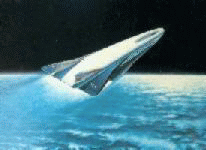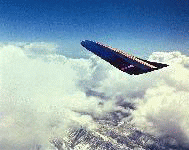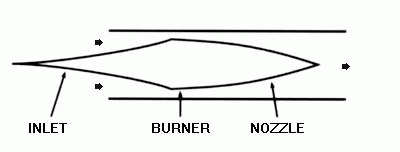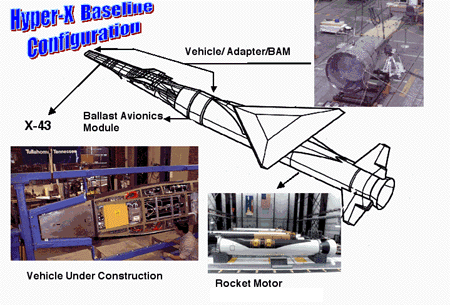[Hypersonic Flight]
[Scramjet]
[Catching the wave]
Hypersonic Flight
Speeds greater than Mach 5 are called hypersonic, equivalent to about one mile per second or approximately 3,600 miles per hour at sea level. A regular passenger plane flies at 0.8 Mach while fast military jets fly at Mach 2. SR-71 Blackbird, the fastest jet flies at Mach 3.2. The fastest rocketplane, X-15 flied once at Mach 6.6 way back in 1960. Russian jets(unmanned) have flown at Mach 6.4. Pretty evident as it is, flying at hypersonic speeds is difficult. According to NASA it is "one of the greatest aeronautical research challenges".
Now why should one fly that fast anyway? :
-
For faster intercontinental travel. The X-30 was expected to cover New York-Tokyo in around 1 hour.
-
To allow seamless entry to space. To exit the atmosphere and park in LEO, a spacecraft must attain a speed of Mach 26(ouch), where it can either deliver payload which can be a satellite or even another vehicle that will travel further.
-
For invincible spy planes and strategic bombers. USAF projects like the Hypersoar are hypersonic craft (Mach 10).
-
Our desire to constantly push the limits.....
There are 2 basic technical challenges that must be overcome to fly at such speeds:
- Number one, is the development of a new type of non-rocket engine.
- and the development of advanced materials including Titanium and its alloys and other composite materials that can handle the heat associated with hypervelocity flight
Apart from the above, the lack of infrastrcture and knowledge required to handle cryogenic fuels in current defence and commercial facilities is a headache.
Current technology is insufficient for useful hypersonic aircraft. New research is going to make them a reality.
The Scramjet
 |
The scramjet engine is the key enabling technology for sustained hypersonic flight.
Propelled by this special type of air-breathing jet engine, a high- performance hypersonic craft might even be able to fly into orbit.- a possibility first considered more than four decades ago. Recently, as the technology has matured and as the demand for more efficient Earth-to-orbit propulsion grows, scientists have begun seriously considering such systems for access to space.
|

|
Air-breathing engines have several advantages over rockets.Because the former use oxygen from the atmosphere, they require less propellant--fuel, but no oxidizer--resulting in lighter, smaller and cheaper launch vehicles. To produce the same thrust, air-breathing engines require less than one seventh the propellant that rockets do. Furthermore, because air-breathing vehicles rely on aerodynamic forces rather than on rocket thrust, they have greater maneuverability, leading to higher safety: flights can be aborted, with the vehicle gliding back to Earth. Missions can also be more flexible.
|

The ramjet is the most basic type of jet engine. In comparison to turbojets, they have no moving parts. They find use only in guided air launched missiles. The aeroplane firing them must be flying at supersonic speeds. Ramjets operate by subsonic combustion of fuel in a stream of air compressed by the forward speed of the aircraft itself, as opposed to conventional turbojet engines, in which the compressor section (the fan blades) compresses the air.

Scramjets (supersonic-combustion ramjets) are those in which the airflow through the whole engine remains supersonic. It is mechanically simple, but vastly more complex aerodynamically than a jet engine. In a scramjet powered aircraft, there must be tight integration between the airframe and the engine. Scramjet technology is challenging because only limited testing can be performed in ground facilities. Long duration, full-scale testing requires flight test speeds above Mach 8. X-43 Hyper-X, NASA's testbed for the scramjet, serves this purpose. To get the engine to that speed, some other power has to be used. In the Hyper-X, this will be provided by OSC's pegasus booster. It must be noted here that scramjets are good only for sustaining hypersonic speeds, not for achieving them from zero.

Because neither scramjets nor ramjets can operate efficiently when they are traveling below Mach 2 or 3, a third type of propulsion (perhaps turbojet or rocket) is required for takeoff. So-called rocket-based combined-cycle engines, which could be used in a space vehicle, rely on a rocket that is integrated within the scramjet combustor to provide thrust from takeoff through subsonic, low-supersonic and then ramjet speeds. Ramjet operation is then followed by scramjet propulsion to at least Mach 10 or 12, after which the rocket is utilized again to supplement the scramjet thrust. Above Mach 18, the rocket by itself propels the vehicle into orbit and enables it to maneuver in space. NASA is currently testing several variations of such a system
Catching the wave
Any aircraft faster than the speed of sound creates a shock wave, as air "piles up" in front of the vehicle. Faster the aircraft, more severe the shockwave. Most hypersonic designs intend to confine the most of the high pressure airflow from the shock wave beneath the vehicle, so that it appears to be 'riding' the top of the wave. This reults in lower drag to lift ratios than other hypersonic designs. In the process also giving them all a characteristic look.
Wave-riding may remind you of 'Compression Lift' seen in the 1960's XB-70 Valkyrie.
Also See :

Comments or Questions? Feel free to mail ST at
[email protected].
This site is best viewed in Internet Explorer 5.5+ and Netscape 6+.





